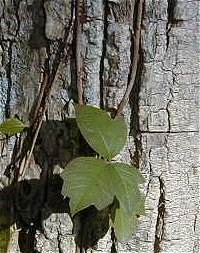Not quite. As it turns out, mango sap is allergy-inducing in the same way that poison ivy is.
 Here's a picture of poison ivy from the Poison Ivy Tutorial. "Leaves of three, let it be" is the common mnemonic for hikers and campers, but the maker of the tutorial offers further information. Jewelweed is a plant that follows this rule, but it actually relieves the effects of poison ivy.
Here's a picture of poison ivy from the Poison Ivy Tutorial. "Leaves of three, let it be" is the common mnemonic for hikers and campers, but the maker of the tutorial offers further information. Jewelweed is a plant that follows this rule, but it actually relieves the effects of poison ivy.The allergenic resin to blame is called urushiol, so named after the Japanese tree -- ki-urushi. Urushiol is an oil that does not cause an allergic reaction the first time you come in contact with it. For people who become hypersensitive, contact dermatitis results upon subsequent exposure. A very itchy rash erupts on their skin and sometimes, it "weeps" with clear fluid.
Mango trees have allergens called mangols. A study done in Japan has shown that urushiol and mangol are cross-reactive.
This means that my brother would break out with a rash if he came in contact with poison ivy even though he might have never seen it before. He might even be allergic to uncooked cashew nut oil and gingko biloba (which is similarly allergenic.)
To add to my brother's worries, current trends in global warming might aggravate his problems. A few weeks ago, the St. Louis Dispatch had this to say:
Scientists have come up with something new to worry about if the level of carbon dioxide in the atmosphere continues to rise: It'll make you itch.Let's try to end on a happier note, shall we? Hm... Poison ivy berries are eaten by songbirds in the winter and they do not break out in hives. It is possible that the cashew-related plants evolved urushiol and mangol as deterrents against mammalian scavengers who might destroy the whole plant in search for tasty berries. The digestive system of mammals is quite strong compared to those of birds, so we might digest and destroy the poison ivy seeds that birds would otherwise carry and propagate.
The noxious vine poison ivy not only grows much faster in a carbon dioxide-enriched atmosphere, but it also produces more urushiol - the substance that causes most people to break out in a rash, says Duke University botanist William Schlesinger.
So the discomfort my brother experiences might just be a product of millions of years of evolution trying to prevent him from enjoying mangos! It's really too bad that he likes them and I hate their slimy texture.





your blogger makes me itchy.
ReplyDelete